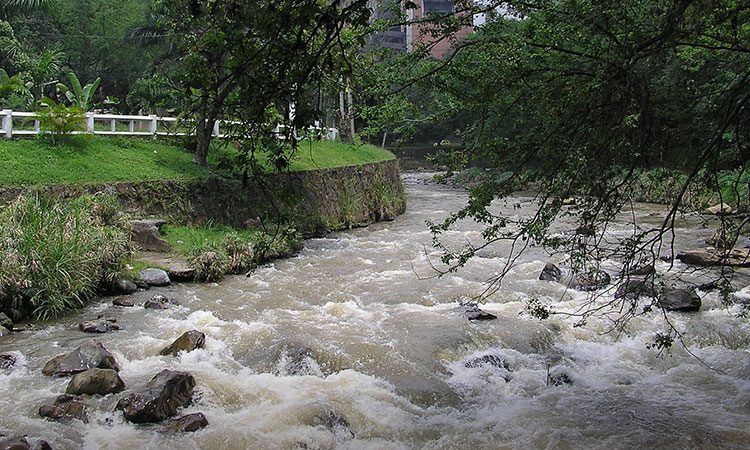The Attorney General’s Office issued an alert about the alarming levels of mercury and lead in the Cali River, a crucial hydrographic basin for the water supply in the capital of Valle del Cauca.
This disturbing discovery emerged from a recent study conducted by the Attorney General’s Office, with the support of the Counternarcotics and Law Enforcement Affairs Section of the United States Embassy.
The study revealed the presence of these toxic elements in the Felidia River, a vital tributary of the Cali River, where levels of 23 parts per million, ppm, were detected, exceeding the limits established by Canadian Regulations and the WHO.
This excess is considered a direct consequence of illegal mining in the Farallones National Natural Park, an illicit activity that threatens both the park’s ecosystem and the quality of the water that feeds six of the seven rivers that supply the city.
Given these alarming results, the Attorney General’s Office has activated an Action Plan that seeks to effectively address this environmental crisis.
This plan involves close collaboration between various authorities, including the Attorney General’s Office, the National Police, the Ministry of the Environment, the Ministry of Defense, the Government of Valle del Cauca, the Mayor’s Office of Cali and EMCALI.
The monitoring and measurement were carried out within the framework of the surveillance commitments agreed upon in the National Mercury Table, convened by the Attorney General’s Office, to review with the competent authorities the severity of the findings and the ongoing environmental crisis.
In addition, it was reported that the Attorney General’s Office will issue a directive with field sampling and will soon publish a diagnostic report on the sites with the highest levels of mercury contamination due to mining activities in Colombia.
The Public Ministry warns that mercury contamination in water sources, a result of illegal mining, is not an exclusive problem in Valle del Cauca.
A similar increase has been observed in different regions of the country, including Antioquia, Córdoba, Chocó, Cauca, Nariño, Bolívar and Santander, with these territories being the most affected.
Councilors against illegal mining
The city faces growing concern about pollution in the Felidia and Pichinde tributaries, derived from illegal mining exploitation in the Farallones.
Councilors such as Roberto Rodríguez Zamudio, Ana Leidy Erazo Ruiz and Terry Hurtado Gómez expressed their alarm, pointing out the lack of government control at the national, departmental and local levels.
For the Councilors, the issue should be evaluated in greater depth and samples should be taken not only in the flat part but also in the mountainous area of the towns of Felidía, Leonera, Andes and Pichinde.
The president of the Council, Carlos Hernán Rodríguez Naranjo, requested that the authorities that have influence in the control of illegal mining in the Farallones be consulted on the issue, to find out the progress in this matter.
Roberto Rodríguez Zamudio, for his part, highlighted the seriousness of the situation, emphasizing that the news is not only the contamination of rivers, but the destruction of ecosystems.
Illegal mining exploitation persists and has increased, with a significant increase in miners and 40 sinkholes that contribute to the destruction of the ecosystem, affecting water quality and local fauna.
“The irreparable damage to the environmental ecosystem of the Farallones should be considered environmental terrorism, because it puts the lives of the people of Cali and Valle del Cauca at risk,” added Rodríguez Zamudio.
Councilor Ana Leidy Erazo Ruiz indicated that the reports made by the Attorney General’s Office should generate an alarm to guarantee drinking water to the residents of the upper part of Felidia and Pichinde, who are those directly affected by this illegal mining exploitation.
“Although Emcali says that at the intake of the Río Cali treatment plant there are no samples or presence of lead or mercury, it surely does occur in those community aqueducts that supply water to the townships,” said Erazo Ruiz.
Councilor Erazo Ruiz recalled that Mayor Jorge Iván Ospina was warned of the burdensome situation that the presence of lead and mercury in local rivers creates for the health of Cali residents.
“We must continue with these technical studies to know which part of the Felidia or Pichinde basin is affected by these mercury and lead discharges,” said the Cabildante.
Councilor Terry Hurtado Gómez, in turn, said that lead, mercury and cyanide in Cali’s rivers is not a new issue.
“There is a message that leaves me concerned and it is what Emcali mentions, regarding the presence of mercury in the water consumed in the city, therefore, we must analyze a little deeper,” said Councilor Hurtado Gómez.
Emcali is pronounced
In a recent joint visit with the Attorney General’s Office and National Parks, encouraging results have been obtained in relation to the levels of mercury and arsenic in the Cali intake.
According to measurements, it has been verified that the levels are at 0 milligrams per kilogram, indicating the absence of problems in this regard.
The discovery has led Emcali to issue a statement of tranquility to the population. These results support the efforts and measures that Cali has implemented for several years to ensure water quality and food safety.
It is highlighted that the city is complying one hundred percent with the established regulations, and there are no indications of problems in this regard.
The call for tranquility is based on the satisfactory levels of regulatory compliance in Cali. The city has been taking preventive and corrective measures to maintain water purity, and these results are a validation of those continued efforts.
The levels of mercury and arsenic are within acceptable parameters, and the population can trust the quality of the water at the intake.
